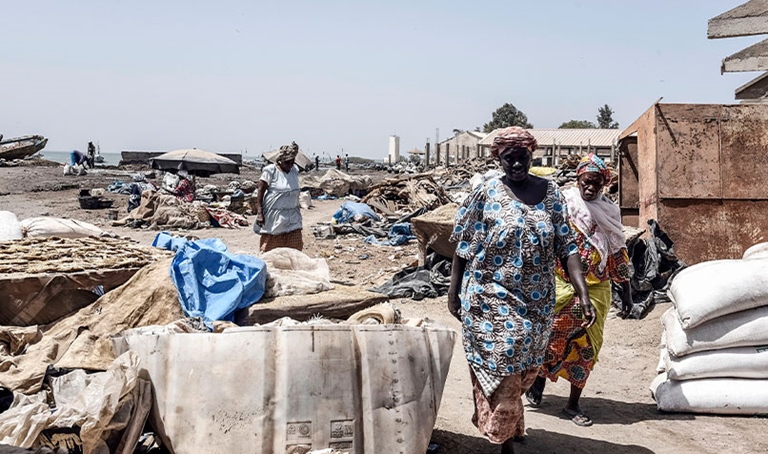Loading component...
At a glance
- In 2020, businesses and governments borrowed close to US$19.5 trillion (A$26.4 trillion), taking the world’s total debt to more than US$281 trillion (A$393 trillion).
- World debt represents more than 355 per cent of global GDP, and the International Monetary Fund (IMF) recommends early action by policymakers.
- The IMF warns that if the current vulnerabilities are not addressed quickly, they could evolve into significant structural problems within the global financial system.
By Gary Anders
Faced with the unprecedented economic chaos caused by population lockdowns, massive job losses and plunging consumer spending, governments and businesses last year borrowed close to US$19.5 trillion (A$26.4 trillion), according to the Washington-based Institute of International Finance (IIF).
The borrowing spree took the world’s total debt to more than US$281 trillion (A$393 trillion) by the end of 2020.
By midway through 2021, total world debt had edged back slightly from the peak, but IIF data shows it is still above US$280 trillion (A$375 trillion). With no end in sight to the pandemic, the debt is set to remain at elevated levels for the foreseeable future.
Combined with a general rise in household debt levels, global debt is at a record high and represents more than 355 per cent of world gross domestic product.
Is high debt a problem? In its Global Financial Stability Report, April 2021, the International Monetary Fund (IMF) warns of “a pressing need to act to avoid a legacy of vulnerabilities”.
In particular, the IMF says national policymakers should be taking early action, including tightening macroprudential policy settings, while at the same time avoiding any broad restrictions to financial conditions.
“They should also support balance sheet repair to foster a sustainable and inclusive recovery,” states the report.
The IMF notes that, if not “urgently addressed”, financial vulnerabilities could evolve into new structural legacy problems weighing on growth or, worse, testing the resilience of the global financial system down the road.
“The global corporate sector has been hit hard by the pandemic. Extraordinary policy support has helped mitigate its impact. But the build-up in corporate leverage resulting from easy financial conditions poses a dilemma for policymakers.”
Taking advantage of record low interest rates, companies around the world have been going to banks to borrow additional capital.
Others have been raising funds from investors through corporate bond issues.
During 2020, corporate bond issuers tapped into buoyant credit markets, issuing a record US$4.4 trillion (A$6 trillion) in investment grade and lower-rated bonds.
Central banks led the debt charge through 2020, embarking on huge bond repurchase programs aimed at helping their respective governments fund financial rescue packages in order to stimulate economic growth.
Those spending programs are continuing, although they are likely to slow gradually during the course of 2021 as COVID-19 vaccine rollouts enable governments to reduce financial support to businesses and individuals and to reopen their economies.
After already completing A$200 billion of Australian Government securities purchases, the Reserve Bank of Australia announced in July this year that it would be buying A$4 billion of government bonds every week until at least 11 November.
Will there be a debt reckoning?

A growing concern, among some at least, is that the global debt mountain may be difficult to conquer.
Will current and future generations still be paying the price of the huge government COVID-19 stimulus packages for years to come, long after the pandemic is brought under control?
It is evident that, to varying degrees, all countries will likely be grappling with higher debt levels for years, which could ultimately have long-term economic and social consequences.
Developed nations have much stronger economic capacity and more policy levers available to reduce their debt levels. These could include new tax measures.
On the other hand, the after-effects for poorer nations that have needed to ramp up their borrowings to deal with the COVID-19 crisis will be longer lasting and potentially harder to fix.
The IMF has made about US$250 billion (A$339 billion) available to its member countries, which is a quarter of its US$1 trillion (A$1.4 trillion) lending capacity.
In addition, the World Bank has made up to US$160 billion (A$217 billion) in financing available to developing countries with limited financial resources to respond to COVID-19.
The World Bank has also committed more than US$26 billion (A$35 billion) as part of the G-20 economies Debt Service Suspension Initiative, which has allowed the world’s poorest countries to suspend the repayment of official bilateral credit.
The IMF says that, in emerging and frontier market economies, countries with market access should take advantage of favourable financing conditions to improve the composition of their debt structure.
“Countries with limited market access will likely need additional assistance from the international community. Other countries facing significant difficulties with debt burdens could benefit from deeper restructuring.”
With interest rates at historical lows, the cost of servicing debt has fallen sharply and is likely to remain manageable for many countries over the medium term.
As the pace of economic recovery quickens, however, central banks may need to resort to lifting interest rates as a means of keeping inflation levels under control.
In fact, expectations of rate rises in developed economies over the next two to three years are increasing, although governments will be treading very carefully with rates to avoid a new wave of corporate and individual loan defaults.
Rising default risks

Credit rating agency S&P Global Ratings notes that, while the continuing recovery of the global economy will likely prevent a debt crisis in the short term, higher global leverage does translate to an elevated default risk.
“Naturally, the shape of the post-pandemic recovery will factor into how much and how quickly corporates, governments and households can trim debt, if at all,” says senior research fellow Terence Chan CPA.
Chan says defaults may hit levels not seen since 2009, following the global financial crisis (GFC).
“Our baseline expectation is for the US trailing 12-month speculative-grade corporate default rate to rise to 7 per cent by year-end, from 6.6 per cent in December 2020. For Europe, the equivalent expectation is 6.5 per cent, from 5.3 per cent.
“Risks to our base case include disorderly reflation, a spike in policy rates or even wider credit spreads, the spread of harder-hitting COVID-19 strains, poor vaccine take-ups, and consumption demand rebounding less than we expect as a result of structural shifts.”
Chan says that S&P expects policy rates to remain low, but creditors fearing inflation or reacting to an unexpected adverse event could reset risk-return expectations, resulting in higher debt servicing costs and reduced accessibility to funding.
“A normalisation of interest rates owing to a strong COVID-19 recovery is natural. That said, the speed and volatility of the path towards normalisation is more of a concern.”
Manageable debt for now
Saul Eslake, independent economist and vice-chancellor’s fellow at the University of Tasmania, says that, as a general observation, there could be an extended period where the interest rate on public debt is less than the growth rate of the economy.
“Hence governments will probably be able to sustain their current debt levels for a lot longer than you might have thought possible a decade ago, when interest rates were a lot higher,” Eslake says.
“There just seems to be a different consensus now, importantly among leaders as well as among others, as to what the likely range of interest rates in the future is going to be.
“There are probably more things to worry about than the level of public debt. In some countries, and Australia might be one of them, the very high level of private debt acts as a constraint on how much the central bank can raise policy interest rates in order to contain any eventual inflationary threat.
“In turn, this kind of reduces the pressure on governments to reduce their debt.”
"Naturally, the shape of the post-pandemic recovery will factor into how much and how quickly corporates, governments and households can trim debt, if at all."
Eslake says that, during the GFC, there were more dire predictions made about possible consequences from the debt governments took on to rescue banks and to provide broad monetary support to economies.
“A lot of governments did rack up debt to bail out banks and to dig their economies out of holes. People made all sorts of dire forecasts as to what they might mean, most of which didn’t come true.
“There were also people who made all sorts of dire forecasts about inflation as a consequence of quantitative easing, which also haven’t come true.
“This shouldn’t be a licence for governments to borrow wilfully and throw cash around as if there was no limit on it. But I’m just saying, it wouldn’t be top of my list of things to worry about.”
Eslake says that even though debt has risen considerably, “it’s not quite the compelling concern that it would have been if all of the other parameters around debt hadn’t changed as much as they have over the last decade, in particular as a result of COVID-19”.
The bigger picture

Despite record-high levels of global debt, factors such as corporate debt and the ratio of household debt to GPD need to be considered when painting a picture of a country's economic future.
Dr Steven Hail, lecturer in the School of Economics at the University of Adelaide, is not concerned with long-lasting effects from COVID-19-related borrowings and says the big debt picture is quite complicated.
“You have to get down into the nitty gritty to really make sense of what’s going on,” Hail says.
“Overall, it’s complicated, and it’s a mistake to add household debt and business debt and government debt, and, when you look at government debt, not to distinguish between currency issuing governments like Australia and governments that don’t borrow in their own currency.”
Hail says government debt in Australia is not an issue, corporate debt is relatively low, and the ratio of household debt to GDP has declined as a consequence of higher savings rates.
“You can add everybody together, and you can say, globally, financial liabilities have gone up. But one person’s financial liability is somebody else’s financial asset.”

